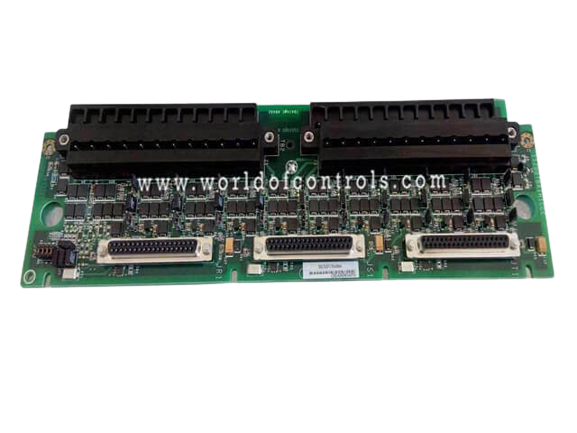
World Of Controls understands the criticality of your requirement and works towards reducing the lead time as much as possible.
IS410TBAIS1C - Analog Input Terminal Board is available in stock which ships the same day.
IS410TBAIS1C - Analog Input Terminal Board comes in UNUSED as well as REBUILT condition.
To avail our best deals for IS410TBAIS1C - Analog Input Terminal Board, contact us and we will get back to you within 24 hours.
SPECIFICATIONS:
Part Number: IS410TBAIS1C
Manufacturer: General Electric
Series: Mark VIe
Product Type: Analog Input Terminal Board
Technology: Surface-mount
Maximum Lead Resistance: 15Ω
Analog output current: 0-20 mA
Input span: 1-5 V dc from 4-20 mA current input
Outputs: 24 V outputs provide 21 mA for each connection
Temperature Range: -30 to 65 degrees Fahrenheit
Compatible Firmware: V05.01 or Later
ControlST Software Suite Version: V06.01 and Later Versions
Input Converter Resolution: 16-bit ADC
Size: 10.16 cm wide x 33.02 cm high
Frequency: 50 or 60 Hz
Humidity: 5 to 95%
Repair: 3-7 Day
Availability: In Stock
Weight: 2 lbs
Country of Origin: United States
FUNCTIONAL DESCRIPTION:
IS410TBAIS1C is an Analog Input Terminal Board Manufactured and designed by General Electric as part of the Mark VIeS Series used in GE Distributed Turbine Control Systems. An analog input terminal board, also known as an analog input module or analog input card, is a device used in electronic systems to interface analog signals from external sources to a computer or control system. It is commonly used in industrial automation, data acquisition systems, and measurement applications. The purpose of an analog input terminal board is to convert analog signals, such as voltage or current, into digital data that can be processed and analyzed by a computer or control system. The board typically consists of multiple channels or input channels, allowing it to handle multiple analog signals simultaneously.
The analog input terminal board usually connects to the computer or control system via a communication interface, such as USB, Ethernet, or a dedicated fieldbus protocol like Modbus or Profibus. The board often provides signal conditioning and isolation to ensure accurate and reliable measurements, filtering out noise and electrical interference. Each channel of the analog input terminal board typically has its own analog-to-digital converter (ADC) to convert the continuous analog signals into discrete digital values. The resolution of the ADC determines the level of detail in the conversion process. Higher-resolution ADCs can provide more accurate measurements by representing smaller changes in the analog signal.
KEY FEATURES AND FUNCTIONS:
Analog input terminal boards come with a variety of features that enhance their functionality and suitability for different applications. Here are some common features you might find in analog input terminal boards:
Channel Configuration: Analog input terminal boards typically offer multiple channels, allowing you to connect and monitor multiple analog signals simultaneously. The number of channels can vary depending on the specific model and requirements.
Signal Conditioning: To ensure accurate measurements, analog input terminal boards often include signal conditioning circuitry. This circuitry may include features like amplification, filtering, and isolation to enhance signal quality, remove noise, and protect the board from electrical interference.
Input Types: Analog input terminal boards support different types of analog input signals, such as voltage, current, thermocouples, resistance, strain gauges, or frequency signals. The board may provide selectable input ranges or different input modules to accommodate various signal types.
Communication Interface: Analog input terminal boards often feature different communication interfaces for connecting to a computer or control system. Common interfaces include USB, Ethernet, RS-232, or dedicated fieldbus protocols like Modbus, Profibus, or EtherCAT. The choice of interface depends on the application requirements and the compatibility with the existing system.
WOC has the largest stock of GE Distributed Turbine Control System Replacement Parts. We can also repair your faulty boards. WORLD OF CONTROLS can also supply unused and rebuilt backed-up with a warranty. Our team of experts is available round the clock to support your OEM needs. Our team of experts at WOC is happy to assist you with any of your automation requirements. For pricing and availability on any parts and repairs, kindly get in touch with our team by phone or email.
FREQUENTLY ASKED QUESTIONS:
What is the purpose of an analog input terminal board?
An analog input terminal board is used to convert analog signals, such as voltage or current, into digital data that can be processed and analyzed by a computer or control system. It serves as an interface between the analog world and the digital world.
What types of analog signals can an analog input terminal board handle?
Analog input terminal boards can handle various types of analog signals, including voltage, current, thermocouples, resistance, strain gauges, and frequency signals. The board may offer selectable input ranges or different input modules to accommodate different signal types.
How does signal conditioning work in an analog input terminal board?
Signal conditioning circuitry in an analog input terminal board enhances signal quality, removes noise, and protects the board from electrical interference. It may include amplification, filtering, isolation, or other techniques to ensure accurate measurements.